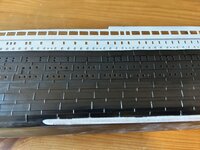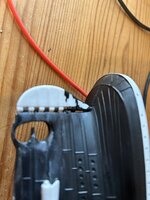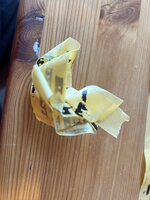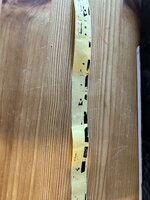- Thread starter
- #41
Oh, well I will just try and fix it. I'll keep you updated on progress.
Follow along with the video below to see how to install our site as a web app on your home screen.
Note: This feature may not be available in some browsers.
Ad: This forum contains affiliate links to products on Amazon and eBay. More information in Terms and rules
Someone please advise on the advantages of using enamels over acrylics, again?? Other than enamels 'may' be more durable when finally cured, I doubt that this is a plus for the models that are being built; unless being given to grandchildren to play with?It may be slight contamination of the area, with "finger grease", tape adhesive etc, possibly combined with too heavy a first coat.
I've been using enamels (Humbrol, Revell and others) for 60 years, and I've experienced similar problems only once or twice.
Some enamel colours have heavier pigments, particularly black paint, and they need a very good stir until the viscosity feels equal and "thin", with no feeling of thicker, "lumpy" pigment, before mixing with the thinners, and then stir again before use.
I'd suggest light sanding of the affected area(s), rather than paint remover, as the latter will probably cause "blistering" which can be hard to remove once fully dried.
Before re-spraying the model, mix a fresh batch of the black paint, and test it on a suitable surface, similar to the plastic of the kit, doing light passes to build up the colour.
It's always best to do two or three light coats to build depth, allowing each coat to thoroughly dry, especially with gloss paint, rather than a heavy first coat.
A heavy coat can cause bubbles and crazing, as the thinners in the paint can't evaporate properly, and therefore the air can't escape, causing the bubble effect.
Point well taken about color 'accuracy' and availability. I will debate though the clogging issues if a proper mix of flow agent and thinner is used when spraying acrylics. But you are absolutly dead on, personal choice is paramount. Clean up??? For me water trumps. I have started using the Vallejo standard model paints for brushing. May be not a smooth as enamel but for me the areas that get this treatment is minimal; cockpit bits and such.Although to an extent it's a matter of taste/preference, enamels, in general, are more durable, easier to work with, especially when airbrushing (virtually no clogging, better flow overall, and easier clean-up overall), and are more versatile, both in the range of accurate colours, and for mixing of colours and actual application in varied "weights" of the coat applied.
They are also much easier to brush-paint, giving a smooth, even finish if applied correctly, nearly always needing just one coat.
Current modelling enamel paints are also very much thinner than they were, say, 40 years ago, so no "clogging" of detail, and most manufacturers supply accurate camouflage colours in their ranges with, for example "Xtracolor" having these in a gloss finish, negating the need for a gloss coat before decals - just apply the required clear finishing coat, if needed.
I have actually used acrylics a few times and, although they gave a good finish, I found they marked fairly easily, and often clogged the airbrush tip, due to the "plasticising" effect as the paint dried in the nozzle, and took more overall effort to clean the 'brush properly.
Also, even though many acrylics users state that enamels give off strong fumes (partly true I guess), I find them no worse than some acrylics, the latter always making my nose clogged and a dry throat.
Unfortunately, it's probable that under the "green" lobby, the days of enamel paints are numbered.
Hope we haven't got you completely confused! As all have stated, whatever feels good, do that.Ok thanks guys. I will work on correcting and then repaiting.
'Learning curve'. We have all been there and as you can see from the majority of builds posted it dosen't take that long to get to 'I'm happy with this'.We'll see if I can get it off at all. If not, it might just be what it is.



